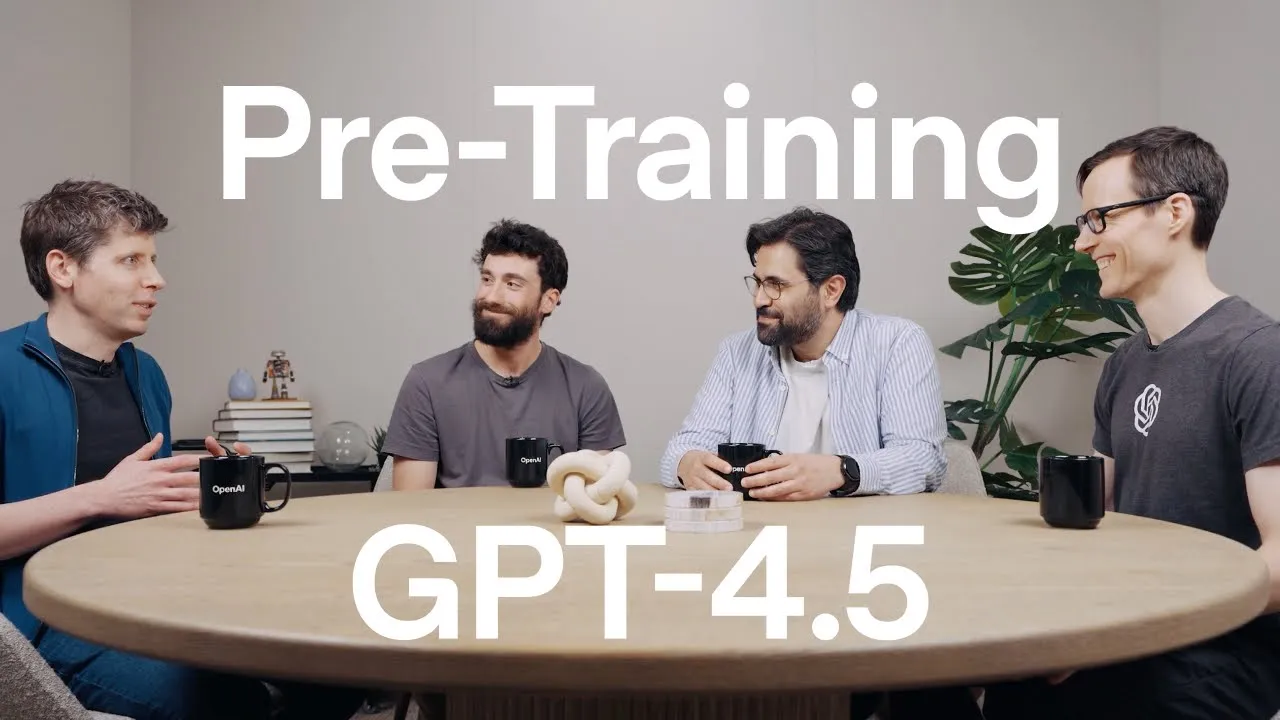
When OpenAI launched GPT-4.5, they knew they had created something impressive, but the overwhelmingly positive reception surprised even them. Users reported experiences that were "way better" than GPT-4 in ways that were both obvious and sometimes difficult to articulate. Behind this leap in capability lies a fascinating story of scaling challenges, system architecture innovations, and breakthroughs in machine learning efficiency.
The Scale Challenge: Training GPT-4.5 from Inception
Training GPT-4.5 wasn't just an incremental improvement over previous models—it represented a massive undertaking that began approximately two years before launch. The team's goal was ambitious: create a model that would be "10x smarter than GPT-4." This required coordinated efforts across multiple teams and disciplines.
"It's a process that starts at inception with a collaboration between ML side and the system side and goes all the way to the time that we know what model precisely we want to train," explains one of the key architects. The scale of the operation demanded significant resources: "A lot of people and a lot of time and a lot of compute."

Why Scaling GPT Pre-Training Is Exponentially Harder
Moving from thousands to tens of thousands of GPUs introduces challenges that go beyond simple linear scaling. Problems that might be rare occurrences at smaller scales become catastrophic at larger scales. The team had to contend with infrastructure failures, network fabric issues, and individual accelerator problems—all while maintaining the integrity of the training process.
"Issues that you observe at scale, if you have a very keen eye, you would observe them at a smaller scale," notes one team member. "It's not that they only manifest at larger scale, but something that is a rare occurrence becomes something that is catastrophic at scale, especially if you haven't anticipated it."
- Infrastructure failure rates increase with scale
- Network fabric challenges become more pronounced
- Individual accelerator issues multiply across larger deployments
- State management approaches needed complete redesign
- Multi-cluster training became necessary as single clusters couldn't provide enough compute
From Frontier to Foundation: The Evolution of Training Capabilities
One of the most interesting insights from the GPT-4.5 development process is how quickly frontier capabilities become standardized. While training GPT-4.5 required hundreds of people and almost all of OpenAI's resources, the team estimates that retraining a GPT-4 level model today would require only 5-10 people.
This dramatic reduction in required resources happens because the hardest part of innovation is often proving something is possible in the first place. As one team member put it: "I think doing anything new is hard. I think even just finding out that someone else did something, it becomes immensely easier because the hard part is having the conviction to do something in the first place. The fact that something is possible is a huge cheat code."
The Data Efficiency Challenge for Future GPT Models
Looking toward future models that might be 10x or 100x more capable than GPT-4.5, the team identifies data efficiency as the critical challenge. As compute resources continue to grow faster than available high-quality training data, algorithmic innovations become essential.
"The transformer, the GPT is spectacular at making productive use of data. It absorbs information and compresses and generalizes to some degree, but its defining character is absorbing the information very efficiently with compute," explains one researcher. "But there's somewhat of a ceiling to how deep of an insight it can gain from the data."

As compute continues scaling exponentially while high-quality data grows more linearly, the standard training paradigm hits a bottleneck. Future advances will require algorithmic innovations that enable models to "spend more compute to learn more from the same amount of data."
System Architecture Innovations for Next-Generation Models
Beyond data efficiency, the next generation of models will require significant advances in system architecture. The GPT-4.5 training process pushed existing infrastructure to its limits, with the team noting that it was "at the edge of what we could keep up with" using their prior stack.
- Fault tolerance co-designed with the workload to reduce operational burden
- Improved state management systems for distributed training
- Multi-cluster training capabilities to leverage compute beyond single clusters
- Better handling of hardware failures at massive scale
The team emphasizes that training at this scale involves constant trade-offs between building the perfect system and making forward progress. "We are always compromising on what is the fastest way to get to this result. The systems is not an end in its own; the product that it produces is."

The Future of GPT Pre-Training
As OpenAI looks toward future model generations, the lessons from GPT-4.5 provide valuable insights. The combination of algorithmic innovations in data efficiency, advances in system architecture, and the accumulated knowledge from previous training runs will all play crucial roles in enabling the next 10x leap in capability.
While the specific details of future models remain to be seen, the path forward involves solving increasingly complex challenges at the intersection of machine learning algorithms, distributed systems, and computing infrastructure. The experience gained from GPT-4.5 has established both a foundation and a roadmap for these future advances.
Conclusion: Lessons from Scaling to GPT-4.5
The journey to create GPT-4.5 illustrates how frontier AI development requires coordinated efforts across multiple disciplines. From managing massive computing infrastructure to solving fundamental algorithmic challenges, each advance pushes the boundaries of what's possible while simultaneously making previous capabilities more accessible.
As these models continue to evolve, the interplay between hardware capabilities, software infrastructure, and machine learning algorithms will remain central to progress. The lessons learned from GPT-4.5 not only enabled its impressive capabilities but also laid the groundwork for the next generation of even more powerful AI systems.
Let's Watch!
Inside GPT-4.5 Training: How OpenAI Scaled 10x Beyond GPT-4
Ready to enhance your neural network?
Access our quantum knowledge cores and upgrade your programming abilities.
Initialize Training Sequence